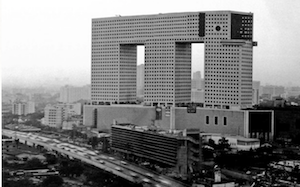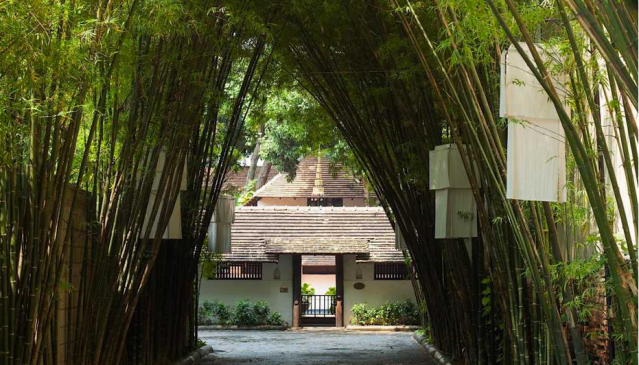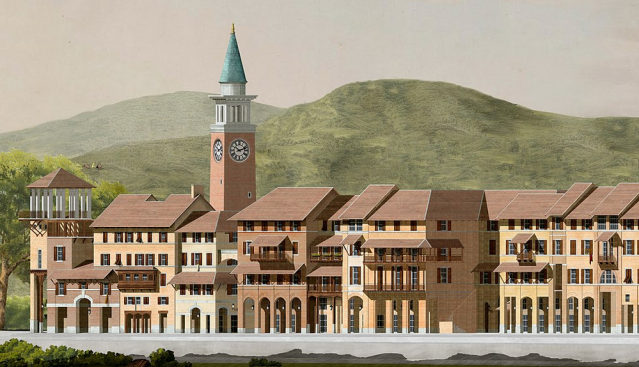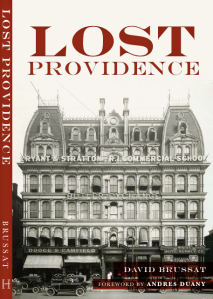
Bank building in Bangkok by Driehaus winner Ong-ard Satrabhandhu. (Ong-ard Architects)
The 2020 Driehaus Prize for Thai architect Ong-ard Satrabhandhu recalls my dinner today. I have just returned from a restaurant called Sawadee, where I continued my quest for an acceptable pad Thai after the closure, last month, of my favorite restaurant, Pakarang, where I’d been wolfing down perfect pad Thai for three decades. Then, poof! Gone.
Not quite “poof-gone” is the idea of Thailand in the Bangkok street above. Guess which building is the bank designed by the latest Driehaus laureate?

Bangkok’s “Elephant Building,” by Ong-ard Satrabhandhu. (atlasobscura.com)
That’s a trick question. I presume it to be impossible to not to guess the one in the middle. The glassy building to its right in the shot could be a skyscraper. If you go to “downtown Bangkok” on Google, you can scroll down to the bottom and see no more than one or two images of Bangkok that might not be anywhere in the world. There may be more Thai restaurants in Providence than traditional Thai buildings in Bangkok per square mile. I’m sure that cannot be so, but that’s what it looks like.
The Driehaus Prize press release describes the architecture of Ong-ard Satrabhandhu as follows:
“The work of Ong-ard Satrabhandhu demonstrates innovation within tradition,” said Michael Lykoudis, Driehaus Prize jury chair and the Francis and Kathleen Rooney Dean of Notre Dame’s School of Architecture. “His projects have a unique beauty that results from incorporating lessons gleaned from years of study across diverse cultures. The resulting buildings seamlessly blend with the vernacular traditions of Thailand.”
Obviously, the bank building in the image on top does not seamlessly blend with the vernacular traditions of Thailand. On the pictured block of that street, at least, no such tradition remains. Neither does Satrabhandhu’s work sit cheek-by-jowl with the sort of modernist buildings he learned to design in the architecture departments of Cornell and Yale during the 1960s, such as his silly Elephant Building in Bangkok. Even the sponsor of the Richard H. Driehaus Prize, the architecture school at Notre Dame, was modernist in those days. The school’s graduation – or shall we say, metamorphosis – from modernist to classical was revolutionary. Beauty dethroned ugliness in the concentration of the school’s curricula. Satrabhandhu’s early work, in the words of the prize jury’s citation,
clearly reflected his modernist education at American schools of architecture — designs of large-scale commercial buildings in Bangkok. His search for meaning in architectural form led him to explore historical sources that conveyed a sense of place with tranquility, and an environmentally responsible culture of building. This search eventually led him to classicism in its truest sense — the immutable tradition of a given culture and the universal components found across time and place.
In recent decades, Satrabhandhu has specialized in single houses and urban groupings of small buildings that blend the Thai vernacular with traditional Western, even classical, forms. That he was able to reach classicism from his modernist initiation bespeaks an independence of mind that, it might be said, distinguishes the architecture school of Notre Dame from almost every other such institution in the U.S. and around the world.
Leon Krier said of the Thai architect: “The authentic vernacular and classical creations of Ong-ard Satrabhandhu stand as vigorous, if lone, way signs to a civilized future.” I wrote a post about him, and on the difficulty of extricating oneself from the modernist trash can, in 2017, “The apotheosis of Ong-ard.”
Bravo to Ong-ard Satrabhandhu! More of his buildings and designs are featured below.
The sister award of the Driehaus Prize, the Henry Hope Reed Award, which honors its namesake’s intellectual work in the groves of classicism, was bestowed upon Clem Labine, the founder of several influential journals dedicated to traditional building. I will devote an upcoming post to the newly minted laureate.
Meanwhile, my quest for a pad Thai good enough to fill the shoes of that dish at Pakarang continues, and may never end. Bee’s is in front, but others, including Sawadee, are close behind, and still more don’t quite suit. If readers in Rhode Island have any suggestions, please let me know!














“The authentic vernacular and classical creations of Ong-ard Satrabhandhu stand as vigorous, if lone, way signs to a civilized future.”
Even when I feel very sympathetic to the buildings and the environment displayed in the photo’s below the text, and sympathetic to the overall traditionalist cause, when reading the marketing style language, one sees a pimped image, instead of a house to live in. Even the marketing of the architectural style which I favour is subject to this modern trend of selling a whole package of images and ideology where you just want something beautiful or pleasant to live in. If I had the choice of obtaining such a house, I would pass on, leave it up to time to dissolve all these marketed images, leave it up to the messyness and natural decay of real life to transform it into something in comparison gorgeously earthly, say, of real living culture.
What is the charm of going out to dine in some restaurant if it is presented with and attached to these marketed images from the architectural scene. Whether it be the traditionalist or the modernist, must they always interfere with your mind, always putting images in it?
“I am dining in an authentic vernacular classical creation, which stands as vigorous and lone”?
Western wide, we have a culture of hyper-reflection and image marketing, which eats at the ability of plain and simple enjoyment, replacing it with images, which are produced by industries with interests.
LikeLike
“The work of Ong-ard Satrabhandhu demonstrates innovation within tradition,” said Michael Lykoudis, Driehaus Prize jury chair and the Francis and Kathleen Rooney Dean of Notre Dame’s School of Architecture. “His projects have a unique beauty that results from incorporating lessons gleaned from years of study across diverse cultures. The resulting buildings seamlessly blend with the vernacular traditions of Thailand.”
This text is representative of the marketing industry, by now they must have templates, spitting out the usual slogans in various formations, adding some contextual data and names. This is not only representative of the architectural sphere, but the whole commercial world, and also the institutional/political world.
One could form an image of a parrot in a birdcage mechanically reproducing the same stuff over and over again in different variations. Mindless is the word which comes in mind, make-belief another.
One could say that if any sector is candidate to be taken over by artificial intelligence technology, it is the marketing sector, and that probably doesn’t even require more advanced technologies then the already existing ones.
LikeLike